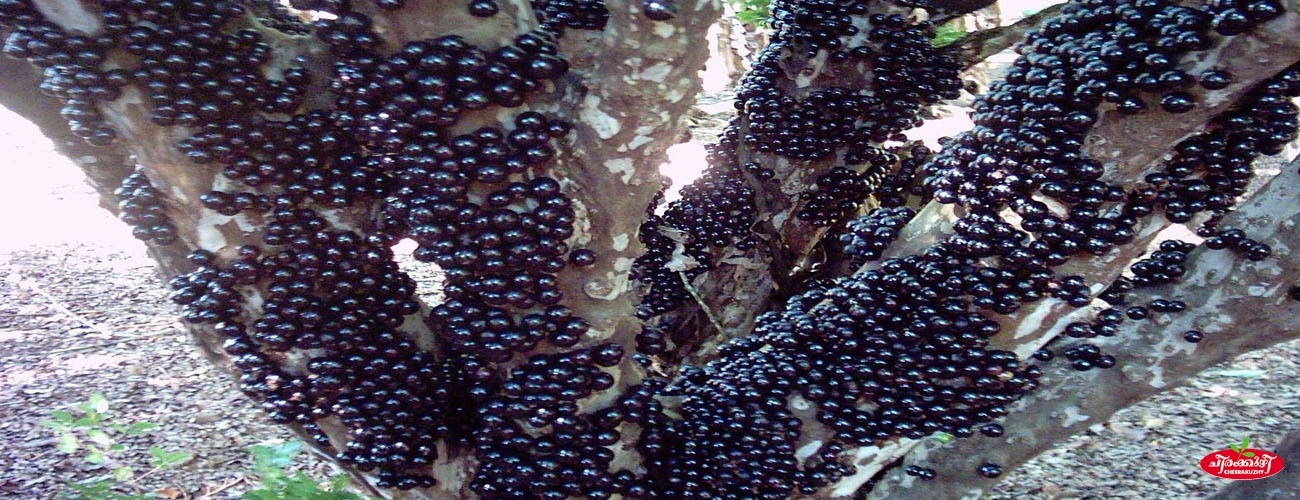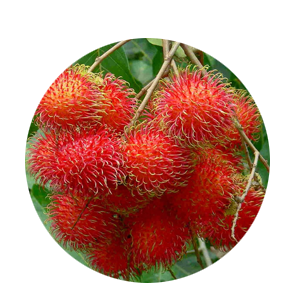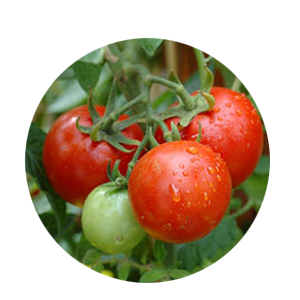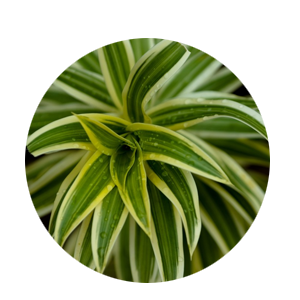Jabotticaba Black - Seedling - (8x10 bag)

Item Description
GENERAL INFORMATION ABOUT JABUTICABA Jabuticaba(Plinia cauliflora) is a native of Brazil and the tree is a slow-growing evergreen that can reach a height of 15 meters if not pruned. It has colored leaves when they are young, which turn green as they mature. The tree may flower and fruit only once or twice a year, but when continuously irrigated it flowers frequently, and fresh fruit can be available year round in tropical regions The Jaboticaba makes an attractive landscape plant.. The fruit is growing on the stems of the plant. The fruit resembles that of a slip-skin grape. It has a thick, purple, astringent skin that encases a sweet, white or rosy pink gelatinous flesh. Embedded within the flesh are one to four large seeds, which vary in shape. It’s used to make jams, tarts, strong wines, and liqueurs. Due to the extremely short shelf-life, fresh Jabuticaba fruit is very rare in markets outside of areas of cultivation. HEALTH BENEFITS OF JABUTICABA POSSIBLE ANTI-CANCER AGENT:-Some preliminary studies have found that Jabuticaba may help to protect against the development of cancer. Jabuticaba contains such anticancer compounds as anthocyanins TREATS DIARRHEA:- Jabuticaba has commonly been used to help treat bouts of diarrhea. When dried, crushed, and mixed with the water, the skin of the jabuticaba slows bowel movements. GREAT FOR ASTHMAS SUFFERERS:-Jabuticaba is a beneficial for those suffering from asthma. Jabuticaba is to keep the airways and passages to the lungs clear by opening bronchi. However, there is currently no evidence supporting this claim
Maintanance, Disease Management And Yielding
MAINTANACE OF THE PLANTATION Once a plantation has been established, the work should not be considered finished. It will be necessary, for example, to protect the plantation against weather, fire, insects and fungi, and animals. A variety of cultural treatments also may be required to meet the purpose of the plantation. FERTILIZING : Acid fertilizer is best but Jaboticaba likes lots of food and will be thankful for just about anything you give it. For young plants half ratio fertilizer at monthly intervals will speed the plant\'s very slow growth rate. Apply organic fertilizers as we as chemical fertilizer in small quantity. WATERING AND WEED CONTROL Young Jaboticaba trees should be watered regularly until fully established. In dry western climates, water mature trees deeply at least every one or two weeks. Desert gardeners may have to water more frequently. Mulch the soil around the trees to conserve moisture. Weeding is also very important. Remove all weeds 1.5 meter around the plant. PEST & DISEASE FOR JABUTICABA Every fruit tree has the future potential for disease and insect damage. Factors such as location and weather will play a part in which issues your tree encounters. If available, disease-resistant trees are the best option for easy care; and for all trees, proper maintenance (such as watering, fertilizing, pruning, spraying, weeding, and fall cleanup) can help keep most insects and diseases at bay. Different combinations of fungicides and pesticides are available in the market. In emergency situation it is recommended to spray required fungicides and pesticides. PRUNING AND SHAPE OF JABUTICABA Early care must be given to avoid heavy branches on the upper portion of the tree as it sets heavy wood very quickly, especially toward its top. If nursery stock is obtained with heavy upper branches, remove them and train the new growth which will appear. Wounds tend to heal quickly. Any wiring should be done loosely and early in the growing season. HARVESTING The jabuticaba tree Jaboticaba fruits are ready to harvest when they have developed a full color and are somewhat soft like a ripe grape.
- Propogation Method : Seeds & Bulbs
- Plant Climate : Sub Tropical, Normal, Cool, Tropical
- Plant Height : 1-2 feet
- Plant Weight : 3.5kg
- Plant Polybagsize : 8x10
Related Images
- Botanical Name : Plini Cauliflora
- Malayalam Name : Jabotticaba
- English Name : Jabotticaba
DELICIOUS PURPLE TREE GRAPE FRUIT
Planting Instructions
PLANT THE RIGHT TREE AT RIGHT PLACE Growing space both above and below ground should be considered when selecting a tree to plant. Too often allowances are not made for the increased size of the tree when it matures. Most problems can be avoided by selecting the proper tree species for the available planting space. GENERAL TIPS 1. Plant at least 3 meter from main overhead utility wires on street or to your home. 2. Plant at least 3 meter from a building. 3. Plant at least 1 meter from sidewalks, driveways, patios and fences. 4. Plant at least 6 meter from other large trees. 5. Plant at least 3 meter from small trees. 6. Prioritize your tree planting with the sun’s direction to maximize shade by planting on the southwestern and western sides of your home BASIC PARAMETERS TO PLANT A JABUTICABA 1.Soil : Jaboticabas grow and fruit best in rich deep soil with a pH of 5.5 to 6.5. Although it is not well adapted to alkaline soils, it may be grown successfully by mulching and applying necessary nutrient sprays containing iron. The tree is not tolerant of salty or poorly drained soil. 2.Planting Distance : • For Commercial Plantation :- young jabuticaba plant distance for commercial plantation is 15-20 ft. (4.7-6 m) • For Home Garden:-In a home garden generally we are planting one or two jabuticaba fruit along with other species of fruit plants. So it is better to keep minimum 3 meter distance from other plants to plant a jaboticaba 3. Pit size : Minimum 60cm width X 60cm Breadth X 60cm depth 4. Sunlight : enjoy full sunlight. 5. Watering: During dry weather, initially water the plant once in two days and after one month of planting water every 7 to 10 days during the first year. TEN TIPS FOR PLANTING A JABUTICABA 1. Dig a hole/pit 3 to 4 times wider than the container (Normally 60cm X 60cm X 60cm is recommended). Fill the pit with top fertile soil to allow for proper root growth. Avoid clay type soil to refill the pit. 2. Add 250 gm Rock Phosphate or Born Meal and 3 to 5 kg Cow dung or compost in the top soil of the pit and mix it thoroughly (Thorough mixing of manure with soil is very important because direct contact of manure with the roots of the plant will cause the damage of roots and plant). 3. Make a small hole in the pit and carefully remove the plant from the container/pot or poly bag keeping the soil around the roots intact. Don‘t yank the plant out of the pot or poly bag as this can separate the roots from the tree. Poly bags can be easily removed by cutting it by a knife and pots can be removed easily by hitting slightly at the top edge of the pot. 4. Set the plant in the middle of the hole. Avoid planting the tree too deep. Keep the base of the trunk is slightly above ground level. Using some soil, secure the tree in a straight position, then fill and firmly pack the hole with the original soil, making sure there aren‘t any air pockets. 5. If the plant is Grafted or Budded make sure the grafted or budded portion of the plant is above the soil. Do not allow to touch the grafted or budded portion in the soil as it burns the skin of the plant. 6. Create a water-holding basin around the pit and give the plant a good watering. After the water has soaked in, spread protective mulch 2–4 inches deep in a 3-foot diameter area around the base of the tree, but not touching the trunk. Also provide a stich as a support for the plant, if needed. 7. The soil and mulch around your plant should be kept moist but not soggy. During dry weather, initially water the plant once in two days and after one month of planting water every 7 to 10 days during the first year. 8. Remove any tags and labels from the tree as these will affect the tree as it grows. You may need to prune any broken or dead branches. For Budded or Grafted plants it is very important that do not allow the growth of off shoots under the grafted/budded portion. Allow the growth of budded/grafted scions only. 9. Do not use chemical fertilizer or any other chemicals on your newly planted trees. Such products will kill your young trees. If needed you can add chemical fertilizers in small quantity (generally below 100gm) after two to three months of planting with sufficient irrigation. 10. Do not over water or allow rain water so much that you see standing water in the pit area of the plant. It will damage the plants roots and results the die of your plant.














